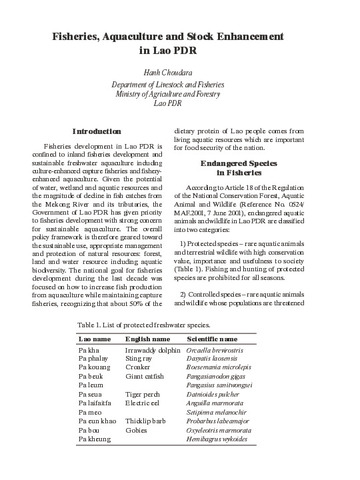Aquaculture-based Restoration and Stock Enhancement of Tiger Shrimps in the Philippines
Share
Abstract
In central Philippines, the Aquaculture Department of the Southeast Asian Fisheries Development Center (SEAFDEC/AQD), with strong collaboration and support from the Research Institute for Humanity and Nature (RIHN) of Kyoto, Japan, has been looking into the stock enhancement of tiger shrimp Penaeus monodon in the New Washington Estuary (NWE), province of Aklan, central Philippines. The NWE was a productive fishing ground that has been suffering from degenerating brackishwater fisheries and estuarine environment. Average daily catch declined from 24 kg in 1970s to only 0.7 kg at present. Shrimp fisheries, the most important livelihood, declined in quality and quantity. Tiger shrimps were abundant in catch until the early 1990s when these were observed to decline in volume, replaced by smaller and cheaper species. This was coincidental with the rapid decline in mangrove cover for ponds and huge increase in fishing pressure. It is clear that crucial interventions are required to restore the tiger shrimp fisheries in the NWE in order to increase income of local fishers, while promoting reduction of fishing gears and restoration of mangroves. Stock enhancement of tiger shrimps shows good potential in answering these needs. Site-specific assessments were conducted to evaluate prospects of shrimp stock enhancement in NWE. Conservative simulations of capture of released stocks showed that fishers can increase income by 300%. To decrease fishing pressure in the area, number of gears per fisher may have to be reduced but shrimp catches will be relatively high-priced. Comparative experiments using aquaculture techniques were done to identify strategies especially in the delicate intermediate acclimation rearing. Aquaculture protocols like those for pond preparation were also adapted to be used in a mangrove pen nursery rearing system for shrimps. Supplemental feeding with formulated feeds increased carrying capacity of the culture area, while enhancing growth and survival of stocks. Culture experiments showed that shrimps grow to 0.5 g within 1 mo and >1g in 2 mo. High stocking density of 40-60 shrimps m super(-2) can be used for <2 mo rearing in a mangrove pen. Release experiments showed that 60-d old shrimps have higher chances of survival when released in the estuaries. With strong support from local communities, government and other sectors, together with effective management and law enforcement, aquaculture-based stock enhancement of tiger shrimps can be a viable intervention to restore livelihood and promote estuarine rehabilitation in the NWE.
Suggested Citation
Altamirano, J. P., Salayo, N. D., Kurokura, H., Fushimi, H., & Ishikawa, S. (2016). Aquaculture-based restoration and stock enhancement of tiger shrimps in the Philippines. In H. Kawamura, T. Iwata, Y. Theparoonrat, N. Manajit, & V. T. Sulit (Eds.), Consolidating the Strategies for Fishery Resources Enhancement in Southeast Asia. Proceedings of the Symposium on Strategy for Fisheries Resources Enhancement in the Southeast Asian Region, Pattaya, Thailand, 27-30 July 2015 (pp. 166-170). Samutprakan, Thailand: Training Department, Southeast Asian Fisheries Development Center.
Subject
environmental degradation  ; marine fisheries
; marine fisheries  ; policies
; policies  ; transplantation
; transplantation  ; stocking (organisms)
; stocking (organisms)  ; sustainable fishing
; sustainable fishing  ; resource conservation
; resource conservation  ; overfishing
; overfishing  ; fishery regulations
; fishery regulations  ; sustainability
; sustainability  ; livelihoods
; livelihoods  ; inland fisheries
; inland fisheries  ; fisheries
; fisheries  ; stocks
; stocks  ; Viet Nam; Notopterus notopterus; Penaeus monodon; Seminabeo notabilis; Cyprinus carpio; Squaliobarbus curiculus; Spinibarbichthys denticulatus; Hamibagrus elongatus
; Viet Nam; Notopterus notopterus; Penaeus monodon; Seminabeo notabilis; Cyprinus carpio; Squaliobarbus curiculus; Spinibarbichthys denticulatus; Hamibagrus elongatus
 ; marine fisheries
; marine fisheries  ; policies
; policies  ; transplantation
; transplantation  ; stocking (organisms)
; stocking (organisms)  ; sustainable fishing
; sustainable fishing  ; resource conservation
; resource conservation  ; overfishing
; overfishing  ; fishery regulations
; fishery regulations  ; sustainability
; sustainability  ; livelihoods
; livelihoods  ; inland fisheries
; inland fisheries  ; fisheries
; fisheries  ; stocks
; stocks  ; Viet Nam; Notopterus notopterus; Penaeus monodon; Seminabeo notabilis; Cyprinus carpio; Squaliobarbus curiculus; Spinibarbichthys denticulatus; Hamibagrus elongatus
; Viet Nam; Notopterus notopterus; Penaeus monodon; Seminabeo notabilis; Cyprinus carpio; Squaliobarbus curiculus; Spinibarbichthys denticulatus; Hamibagrus elongatus
Related items
Showing items related by title, author, creator and subject.
-
Fisheries, aquaculture and stock enhancement in Lao PDR
Choudara, Hanh (Aquaculture Department, Southeast Asian Fisheries Development Center, 2006)Fisheries development in Lao PDR is confined to inland fisheries development and sustainable freshwater aquaculture including culture-enhanced capture fisheries and fishery-enhanced aquaculture. Given the potential of ... -
Status of Fishing Conditions in Japan in Relation to Responsible Fisheries
Inoue, Yoshihiro; Chopin, Frank (Training Department, Southeast Asian Fisheries Development Center, 1997)The presence of a large number of species that are low in quantity in Japan's coastal waters has resulted in the evolution of a food culture that has historically utilized most of the catch species and sizes that are caught ... -
Current Status of Fish Stock Enhancement in Thailand
Ingthamjitr, Suchart; Sricharoendham, Boonsong (Training Department, Southeast Asian Fisheries Development Center, 2016)Aquatic animals from natural waters have long been exploited by rural poor as cheap protein food. Natural waters including rivers, canals, swamps, lakes, large reservoirs, and small water bodies are significantly exploited ...




